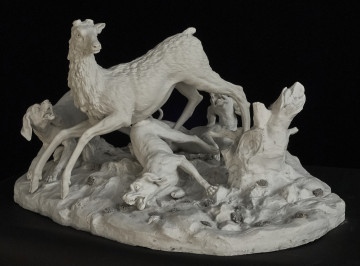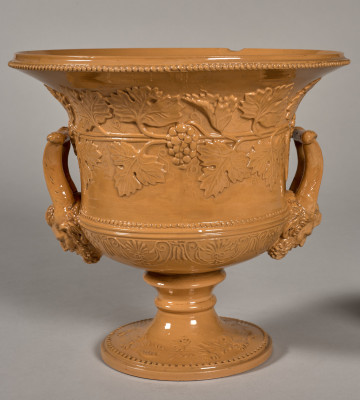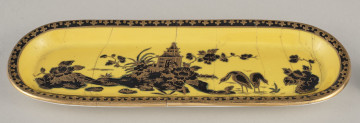
Deer attacked by hounds
19th / 20th century
Castle Museum in Łańcut
Part of the collection: ceramics
Vase Water The large, decorative vase symbolising water was probably made in the porcelain factory in Meissen. This porcelain factory, the oldest in Europe, was established in 1710 by Augustus II the Strong and still operates today. The above vase was created in the 19th c. according to the model of the vase symbolising water from the 1747 Meissen series of four vases depicting the four elements: air, fire, water, and earth. The author of these Rococo-style vases was Johann Joachim Kaendler, a sculptor working in the Meissen factory since 1731, later the head of the modelling shop. He is considered the greatest porcelain modeller in Europe. All four vases from the series, which probably come from the 18th c., were in the collection of the former owners of the Łańcut castle (J. Piotrowski, Zamek w Łańcucie, Lviv 1933, p. 65, 66, fig. 67). They were taken abroad by Alfred Potocki, the last owner of the Łańcut castle. The above vase, symbolising water, was purchased by the museum in 1984. The openwork vase has a slender ovoid belly and a conical neck. It has a rich artistic setting. The round base imitates the seashore. On the back, it is modelled into a pile of stones with a crayfish crawling over them. On the front, it is modelled into foamy sea waves and rocaille. On the stone, there is a sitting cupid imagined as a fully plastically modelled figurine with a fishing net thrown over the shoulder, holding a coral in his hand. The cupid figurine constitutes the main accent of the sculptural ornamentation of the vase. Green leaves of reeds grow out of the base and creep high on the sides of the openwork belly. The scenery is complemented by an eel crawling inside the neck of the vase, sticking its open mouth outside of the belly through an opening in the front of the vase. Barbara Trojnar
Author / creator
Dimensions
height: 58.5 cm, width: 32 cm
Object type
Ceramics
Technique
gilding, overglaze paints, underglaze paints
Material
porcelain
Origin / acquisition method
purchase
Creation time / dating
Creation / finding place
Owner
Castle Museum in Łańcut
Identification number
Location / status

19th / 20th century
Castle Museum in Łańcut

19th (?) century
Castle Museum in Łańcut

20th century
Castle Museum in Łańcut
DISCOVER this TOPIC
National Museum in Szczecin
DISCOVER this PATH
Educational path